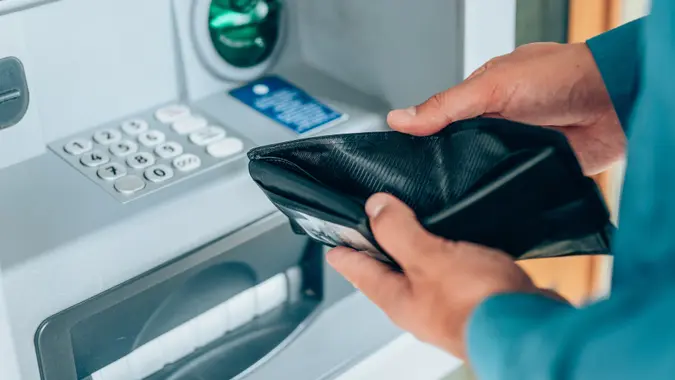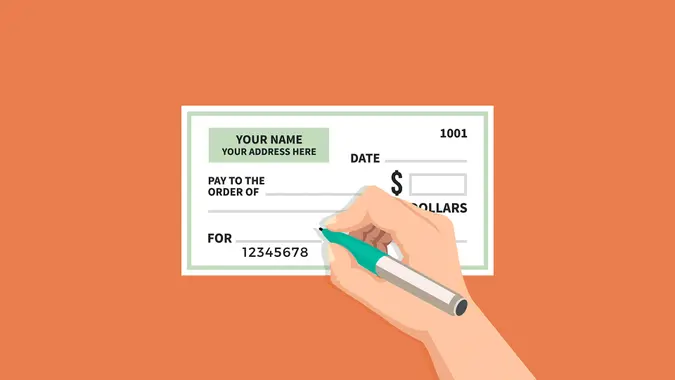Wire Transfer Fees: What You’ll Pay and How To Avoid Them

Commitment to Our Readers
GOBankingRates' editorial team is committed to bringing you unbiased reviews and information. We use data-driven methodologies to evaluate financial products and services - our reviews and ratings are not influenced by advertisers. You can read more about our editorial guidelines and our products and services review methodology.

20 Years
Helping You Live Richer

Reviewed
by Experts

Trusted by
Millions of Readers
When you need to send a large sum of money quickly and securely, a wire transfer is a reliable option. It’s faster than mailing a check and safer than sending cash — but it usually comes with a fee. A wire transfer fee is what banks charge to process the transaction, similar to any other service fee. Keep reading to learn more about how much banks may charge for this service.
How Much Are Wire Transfer Fees?
Wire transfer fees usually fall within the following range, regardless of which bank you use.
| Type of Transfer | Fees |
|---|---|
| Domestic | $15 to $30 |
| International | $35 to $50 |
Be aware that sending money internationally may involve additional fees for currency exchange or third-party bank processing.
Wire Transfer Fees by Bank
Wire transfer fees vary by bank and type of transfer. Here’s how some of the biggest banks compare.
| Bank | Wire Transfer Fees |
|---|---|
| Ally | $20 for all transfers |
| Bank of America, Member FDIC | -$15 to $30 for domestic wire transfers -$0 to $45 for international wire transfers |
| Capital One | $0 to $30 |
| Chase | -$0 to $35 for domestic wire transfers -$0 to $50 for international wire transfers |
| Citi® | $0 to $65, depending on the customer’s account tier |
| Navy Federal Credit Union | $0 to $25 |
| U.S. Bank | -$0 to $30 for domestic wire transfers -$0 to $50 for international wire transfers |
| PNC Bank | -$0 to $30 for domestic wire transfers -$15 to $50 for international wire transfers |
| TD Bank | $15 to $50 |
| Regions Bank | -$15 to $25 for domestic wire transfers -$18 to $45 for international wire transfers |
Good To Know
The cost of a wire transfer can depend on several factors, including:
- Your bank
- The type of bank account you have
- Domestic vs. international transfers
- Incoming vs. outgoing wires
- How the wire is sent — in person, online or by phone
- Whether currency conversion is needed
5 Ways To Avoid or Reduce Wire Transfer Fees
Here are some simple tips to help reduce or eliminate wire transfer fees.
1. Use Online Transfers
Many banks and services offer lower fees for online transfers compared to in-person or phone transfers. Check if your bank has a mobile app or website platform for cheaper options.
2. Choose the Right Service
Compare different banks or transfer services to find the one with the lowest fees. Some services, such as online money transfer apps, may have minimal or no fees compared to traditional banks.
3. Look for Promotions
Check for special deals or promotions that waive the fee to wire money, especially if you’re a new customer or sending your first transfer.
4. Bundle Your Transfers
Instead of sending multiple small transfers, combine them into one larger transfer to avoid paying various bank fees.
5. Ask Your Bank
Some banks offer free wire transfers for customers who hold specific types of accounts, such as premium or high-balance accounts. Check with your bank to see if you qualify for fee waivers.
Alternatives to Wire Transfers
Not sure if a wire transfer is the best choice? Check out these popular alternatives.
- ACH transfers: These bank-to-bank transfers allow businesses or individuals to set up direct deposits and recurring payments. The service is free, but there are some limitations on who can use it.
- Electronic funds transfer (EFT): A convenient way to move money between bank accounts. EFTs are typically fast and free, especially when transferring funds between accounts in your own name.
- Online bill pay: You can schedule payments using this service. It’s a digital method of paying for utilities or goods.
- Peer-to-peer payment platforms: Apps such as PayPal, Venmo and Zelle can be a cost-effective way to transfer funds domestically and internationally.
Final Takeaway: Is It Worth Paying a Wire Transfer Fee?
Whether or not it’s worth it to pay a wire transfer fee depends on the situation. It might be worth it for the added convenience or for one-time purchases, such as buying a property. But if you regularly wire money to others, it may be worth it to explore other cheaper options like EFTs or peer-to-peer payments.
FAQs on Wire Transfer Fees
Still have questions about wire transfers? Here's what else you need to know.- What is a wire fee?
- A wire transfer fee is a service charge for completing a wire from one account to another. Depending on the bank, you might have to pay an incoming fee for receiving a wire and an outgoing fee for sending one.
- How much is the service for international bank transfers?
- The service fee for international bank transfers typically ranges from $30 to $50. It depends on the financial institution, the type of international transfer and your account status. For example, some banks charge lower fees for high-tier accounts.
- Which banks have the lowest wire transfer fees?
- Navy Federal, PNC Bank and U.S. Bank offer some of the lowest wire transfer fees, including options with no fees.
- Are wire transfers over $10,000 reported to the IRS?
- Banks generally report wire transfers that are over $10,000 to the IRS. It's a regular part of business for the bank. It doesn't necessarily mean that you owe taxes on the money, but it does mean that there's a record of the cash transaction.
- What is the cheapest way to send a wire transfer?
- The cheapest way to send a wire transfer is to complete it online through your existing bank account. Some banks charge additional fees for setting up the transfer in person. You can always call your bank to ask about current promotions or suggestions for how to save.
Allison Hache and Aja McClanahan contributed to the reporting for this article.
Information is accurate as of July 24, 2025.
Our in-house research team and on-site financial experts work together to create content that’s accurate, impartial, and up to date. We fact-check every single statistic, quote and fact using trusted primary resources to make sure the information we provide is correct. You can learn more about GOBankingRates’ processes and standards in our editorial policy.
- Consumer Financial Protection Bureau. 2024. "What is a wire transfer?"
- Discover. 2024. "Can You Do a Wire Transfer from a Credit Card?"
- Chase. "How to wire money."
- IRS. 2025. "Form 8300 and reporting cash payments of over $10,000."
 Written by
Written by  Edited by
Edited by 
























